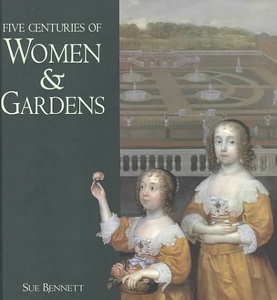 The National Portrait Gallery in London reopened this June after three years of closure due to Covid (and refurbishing). To celebrate, readers can pick up this excellent book from 2000, written to support an exhibition at the Gallery.
The National Portrait Gallery in London reopened this June after three years of closure due to Covid (and refurbishing). To celebrate, readers can pick up this excellent book from 2000, written to support an exhibition at the Gallery.The women and gardens in the title of Sue Bennett’s Five Centuries of Women & Gardens are British women and British gardens, each account supported by elegant portraits and some fine garden views. Bennett manages to include in each brief text biographical information, clear descriptions of the gardens, and just enough social history to place everything in context. The reader learns how gardens changed over the centuries, as well as how women gradually gained legal and social control over their gardens and their lives.
The subjects begin with Queen Elizabeth I and end with Beth Chatto. The Elizabethan gardens were created for and about the Queen, not ordered by her. Nobles currying favor developed gardens symbolically worshipping her as the Virgin Queen, using topiary, fountains, and privet hedges.
Queen Caroline, wife of George II, developed gardens at Hyde Park, Kensington, and especially Richmond Lodge. Each focused on supporting the legitimacy of the Hanoverian kings, recently imported from Germany and not very popular. At Richmond her garden included a hermitage with a live hermit and “Merlin’s Cave,” a thatched cottage and grotto meant to connect the royal family to Merlin’s prophecy. Alas, the public response was ridicule.
In the 20th century Miriam Rothschild (1908-2005) turned very unlikely fields into meadows full of wildflowers, restoring medieval views. Rothschild, a scientist sometimes called “Queen of the fleas” because of her research into them, also decoded at Bletchley during World War II. In 1970, as a retirement project, she scattered wildflower seeds collected from a derelict airfield over the remnants of a tennis court on her property. In ten years her meadow had nearly 100 species of flowers and grasses She then sent out her seeds for use in other areas of the country. The National Trust adopted some of her ideas, and Prince Charles (now Charles III) worked with her on a wildflower garden at his estate at Highgrove.
“Five Centuries of Women and Gardens” gives surprisingly complete pictures of the connections women have had with their gardens. Each woman appears as a lively personality, accompanied by a dazzling portrait.
Reviewed by Priscilla Grundy in Leaflet for Scholars, Volume 10, Issue 11, November 2023.